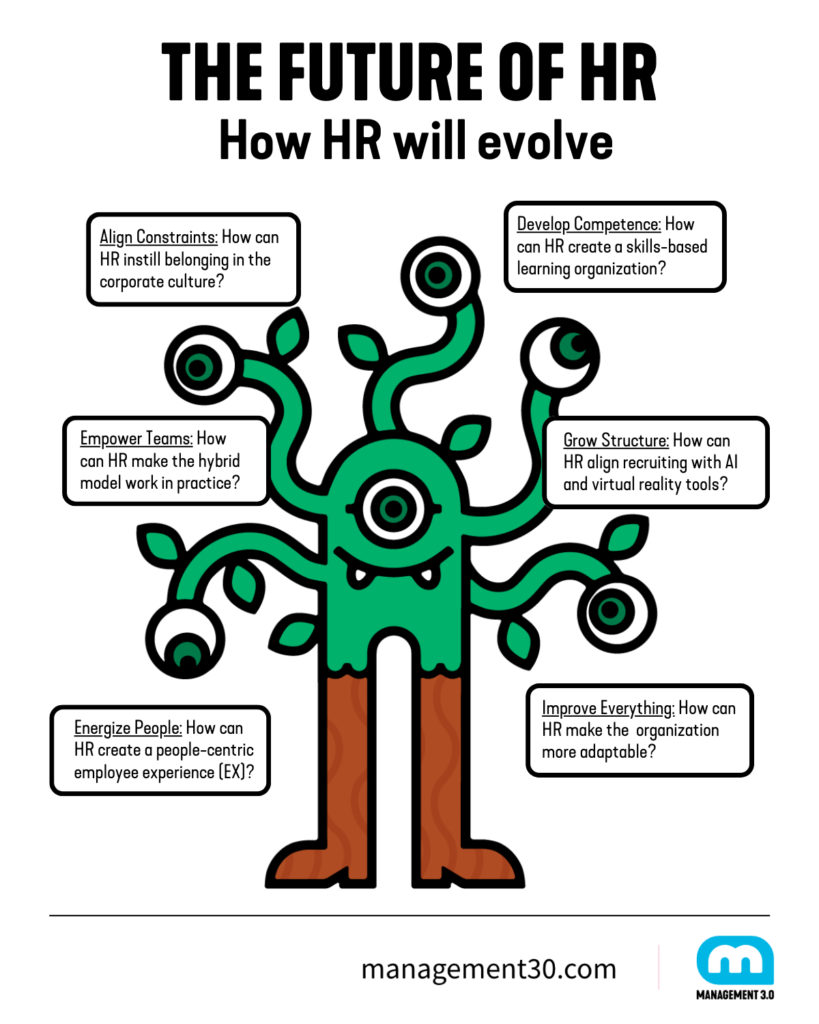The world of work is rapidly changing after the Covid-19 pandemic and new organizational trends and needs are emerging. Human resources leaders need to take part in redesigning the future of work by focusing more on culture change, agility, and complexity, says Management 3.0 Facilitator Ilija Popjanev. Here is how:
Do you remember Martie, the Management 3.0 Monster? Martie has six views on organizations and is representing the different aspects of Agile management. Let us discover how, according to the six views of Martie, HR will evolve.
- Energize People: How can HR create a people-centric employee experience (EX)?
- Empower Teams: How can HR make the hybrid model work in practice?
- Align Constraints: How can HR instill belonging in the corporate culture?
- Develop Competence: How can HR create a skills-based learning organization?
- Grow Structure: How can HR align recruiting with AI and virtual reality tools?
- Improve Everything: How can HR make the organization more Agile?
Energize People: How can HR create a people-centric employee experience (EX)?
HR leaders need to focus on creating a people-centric employee experience that fosters a positive, inspirational, and supportive work environment and helps employees feel valued, engaged, and invested in their work.
To meet employee expectations for fulfillment in their EX, HR leaders should work to target each of these dimensions and align personal achievements to common purposes, encourage autonomy, and promote development tailored to individual needs and passions, but also incorporate continued recognition of success into the employee’s entire journey in the organization.
Use Kudo Cards to get team members to recognize each other for submitting creative ideas related to improving the EX. Later on, employees can vote for the best ideas, and they will have the chance to present their solutions to HR leaders at their retrospective events.
HR leaders should involve all employees to encourage them to participate in this culture-shaping activity which directly improves their experience, resulting in increased employee loyalty, engagement and happiness.

Empower Teams: How can HR make the hybrid model work in practice?
Employee expectations have shifted following the pandemic; their most important need is the flexibility to work from home. HR leaders play a big role in building better employee experiences, so they need to be agile and open to experiments and failures to improve the new way of working.
At the moment, there is a huge gap in perspectives between employees and employers, whether the hybrid model enhances or impacts productivity or not.
Solving the “Productivity Paradox” is a big opportunity for HR leaders to design the future of work, one that is fully adaptive to hybrid work, and one that also has purpose, value and culture at its heart.
HR leaders can foster a culture of trust by focusing on outcomes, rather than outputs and measuring the hours worked. By emphasizing performance and accountability, HR leaders can help to ensure that employees feel empowered and trusted to work in the way that is most effective for them. They can facilitate collaboration among remote and in-person employees by providing fresh and engaging tools that enable virtual events and knowledge sharing, so employees will feel connected and engaged, regardless of their physical location.
HR leaders need to experiment with the hybrid model over time and adapt new emerging practices and principles as needed. This can include gathering regular feedback from employees, analyzing data, and making adjustments to procedures, always taking care over the employee’s mental health and well-being, and maintaining a work-life balance, while the needs of the business are simultaneously met.
The practices and approaches HR leaders will take must be unique to every company, keeping in mind the business context and culture elements of the organization, and the impact they want to create both for employees and for the organization.
To better understand which practices are working, and which are not, HR leaders may use Celebration Grids as retrospective tools, through which each organization’s teams will share best practices, removing impediments and anti-patterns of the hybrid model.

Align Constraints: How can HR instill belonging in the corporate culture?
Changing culture and shifting mindsets are complex problems, and they are very difficult for HR leaders to accomplish. The complexity of culture change puzzles HR leaders, often leading to a failure to deliver this task. We must keep in mind that besides those who struggle with complexity thinking skills, many HR leaders are lacking sufficient power in the organization to deliver significant cultural change.
Each HR leader should understand the correlation between psychological safety from one side and DEIB (diversity, equity, inclusion and belonging) from the other side, because cultural issues cannot be resolved without having a higher sense of purpose and understanding of the impact that all mentioned factors have on organizational culture.
HR leaders cannot solve complex cultural issues by focusing on isolated parts or by “simplifying complexity”. They instead need to find other ways to treat complex cultural issues, while retaining the big picture or “the north star”, which, in this case, is the sense of “belonging” or the feeling when employees feel accepted in the team, the tribe, the community of the organization: they are welcomed with all their needs, traits, strengths and weaknesses.
When belonging works in the organization, employees feel that they can be authentic, original and creative, bringing their full talents to work and taking ownership of the results.
Belonging is the secret glue and currency that drives corporate reputation and success, because when employees have a higher sense of belonging, they know the role they have in the success of the business and they always take the extra step. They become authentic leaders and role models, empowering teams and improving connections at work, which results in better collaboration and synergy.
Use Personal Maps as one of the foundational HR practices for instilling belonging in the workplace.

Develop Competence: How can HR create a skills-based learning organization?
In traditional HR, job descriptions have been the dominating structure for work—defining how work is done, by whom, how it is managed, all defined by HR practices, from hiring to performance management.
According to the World Economic Forum, by 2025, half of all employees worldwide will need reskilling due to the technological disruption which has taken place over the past few years; this emphasizes a shift in employees’ development needs and a need to upgrade skills related to the future of work trends.
In response to skills vs. jobs, Unilever’s new motto is: “We’re beginning to think about each role at Unilever as a collection of skills, rather than simply a job title.”
HR leaders should reconsider applying a different concept: a skills-based model to meet the demands for agility, volatility and complexity involved in the new way of working.
Skills-based organizations are focused on decoupling some work from the job, either by atomizing it into tasks or projects, so it is more focused on problems to be solved, outcomes to be achieved, or value to be created. Employees can be freed from being defined by their jobs and instead be seen as whole individuals with skills and capabilities that can be fluidly deployed to match their interests, while evolving to align with business priorities.
This concept makes organizations have a scalable, manageable, and more equitable way of operating. Instead of turning people towards the same kind of standardized jobs and roles, skills-based organizations let an employee’s uniqueness shine through, with work tailored to their strengths.
Refocusing work around the people doing it and the skills required to do so, while supplying the necessary skills training, can also promote equity according to a survey by Deloitte in which 80% of business leaders say making decisions about hiring, pay, promotions, succession, and deployment based on people’s skills, rather than their job history, would reduce bias and improve fairness.
According to the same survey, half of the employees said they are more likely to be attracted to and remain at an organization that grants them an increased choice in how they apply their skills to work. Although workers want to realize their full potential and be seen as individuals, only 26% of workers strongly agree that their employer treats them as whole individuals who can offer unique contributions and a distinctive portfolio of skills to the organization.
HR leaders can implement the new concept of skills-based organizations by using the Team Competence Matrix as enabling HR practice.

Grow Structure: How can HR align recruiting with AI and virtual reality tools?
2023 is a year teeming with high technology. AI and virtual reality trends are impacting HR, mostly in the areas of process improvement, efficiency and productivity, meaning that AI tools can help achieve these goals. By utilizing AI-powered tools, HR leaders can save time, reduce costs, and improve the quality of their hires.
Also read: Leadership in the era of AI
In addition, virtual reality has been growing in popularity in HR, and can be used for hosting virtual job fairs, interviews, employee onboarding, training and much more.
Hiring interviews can take place in a virtual environment, and virtual training sessions can be beneficial in some areas that require specific equipment. HR leaders will recognize the value of adopting automated intelligent hiring platforms with pre-employment assessments and interview technologies to help them select better candidates and improve their experience during the hiring process.
AI-powered screening tools can help HR leaders process large volumes of resumes quickly and accurately. These tools can scan resumes for specific keywords and criteria that match the job requirements and identify top candidates for further consideration.
HR leaders may also conduct virtual interviews with candidates by using machine learning algorithms to analyze the candidate’s responses and identify the best fit for the job. AI tools can use the STAR(T) behavioral questioning model to improve the candidate experience during the interview and to hire the best cultural fit from the candidate poll.
AI-powered assessment tools can help HR leaders evaluate a candidate’s skills and aptitude for the job. These tools can use simulations, gamification and other interactive assessments to evaluate the candidate’s ability to perform specific tasks related to the job.
Virtual reality and AI will be applied in onboarding, training, DEI, culture, recruitment and selection, because AI and VR can identify and eliminate biases in the process, but can also simulate hands-on scenarios that feel almost like a real-life experience.
The use of AI and VR will become profound for HR leaders in the next few years; it will become the future of work catalyst for change and the builder of amazing experiences.

Improve Everything: How can HR make the organization more adaptable?
HR leaders understand the importances of a mindset shift, continuous improvement, psychological safety, empowering teams and collaborative approaches as key drivers for the future of work.
They can start testing and practicing various agile practices, such as using Scrum for leading HR projects, Kanban boards to visualize, identify, prioritize and improve HR operations, recruiting, onboarding, performance evaluations, as well as using Management 3.0 practices to improve employee happiness.
By embracing an agile mindset, HR teams can be more responsive to change and the needs of the organization, driving positive impacts for both employees and the organization as a whole.
HR leaders should encourage tracking metrics by implementing transparent OKR’s in the entire organization to analyze data and to assess the value and impact of different HR initiatives.
They should reconsider the value of the organization’s Agile Coaches who help enhance agility by working on multiple projects, operations and stakeholders simultaneously, operating across the whole function to continuously implement and adopt agile tools, skills and mindsets.
HR leaders can use design thinking and UX research tools to better understand work experiences and how people interact with HR’s processes and systems to reveal employee behavior, their core drivers and motivators, and use data to build various personas to improve the employee journey.

The Future of HR: What’s next in 2023 and beyond
The new VUCA world demands an adaptive way of working not only for HR, but for the entire organization, while Agility in HR instills creativity, innovation and resilience. It is also about delivering value and knowing how to better prioritize an organization’s crucial challenges based on the value delivered to all stakeholders. We can embrace agility not as a new HR skill, but as a new mindset to be adopted.









